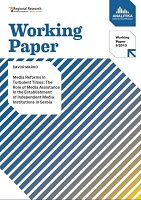Media Reforms in Turbulent Times: The Role of Media Assistance in the Establishment of Independent Media Institutions in Serbia
Media Reforms in Turbulent Times: The Role of Media Assistance in the Establishment of Independent Media Institutions in Serbia
Author(s): Davor Marko
Contributor(s): Kristina Irion (Editor), Tarik Jusić (Editor), Sanela Hrlović (Editor)
Subject(s): Politics, Media studies, Communication studies, Policy, planning, forecast and speculation, Public Finances
Published by: Analitika – Centar za društvena istraživanja
Keywords: Serbia; media; media institution; media assistance role; reforms; independent media;
Summary/Abstract: The Republic of Serbia is located in the central part of the Balkan Peninsula, and is one of seven independent states, established after the break up of multiethnic socialist Yugoslavia. Following the wars at the beginning of 1990s, Serbia remained, together with Montenegro, under the umbrella of the Federal Republic of Yugoslavia until 2003 when the State Union of Serbia and Montenegro was formed. In 2006 Montenegro declared its independence from the State Union. A year later, after it was administered by UNMIK on the basis of the UN Resolution 1244, the territory of Kosovo declared its independence as well. Serbia does not recognize the declaration of independence of Kosovo, but considers the act illegal and illegitimate. Serbia is a parliamentary republic with a multi-party system. The National Assembly is unicameral, composed of 250 representatives who serve four-year terms. Executive authority is exercised by the prime minister and the government. The president is the head of state, elected by popular vote; the role is ceremonial with little executive, legislative, or judicial authority. In 2011, Serbia’s population (excluding Kosovo) was slightly above 7 million people. The majority of the population is comprised of ethnic Serbs (82.9%), while the rest are diverse minority ethnic groups (the largest are Hungarians with 3.9%, Bosniaks 1.8%, Roma 1.4%, etc). Belgrade is the capital of Serbia.
Series: ANALITIKA — Working Paper
- Page Count: 58
- Publication Year: 2013
- Language: English
- Introduction
- Content File-PDF

